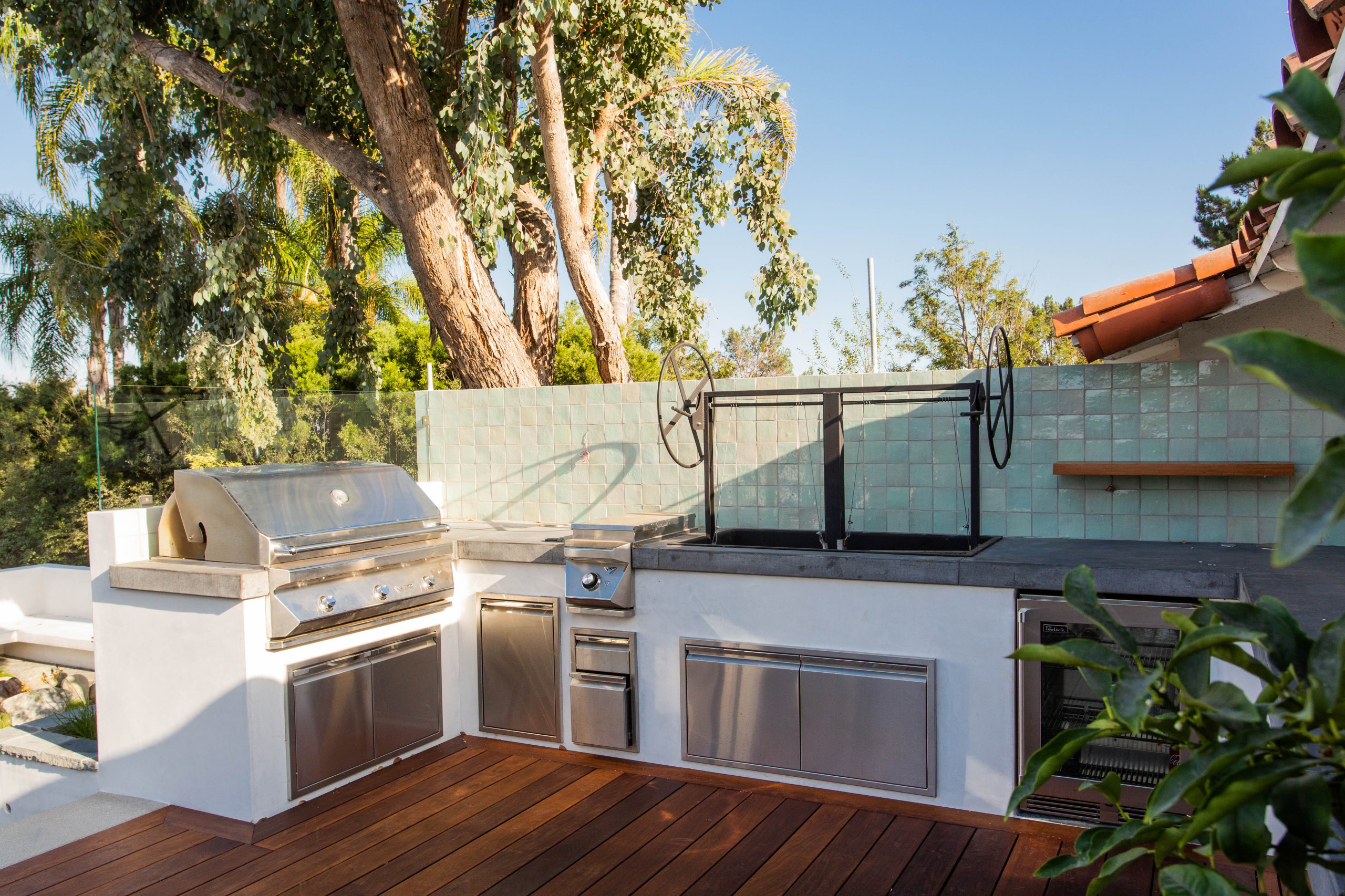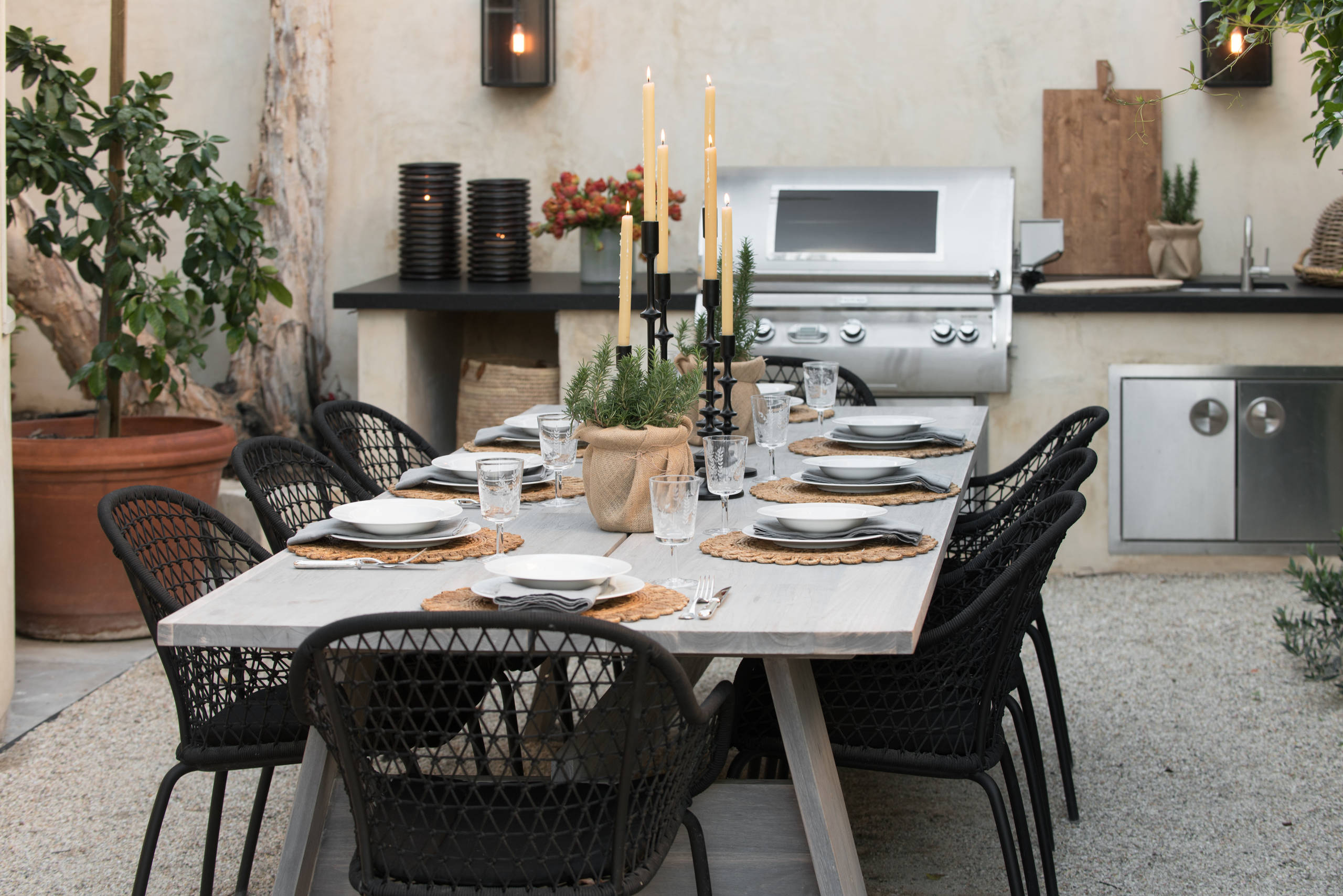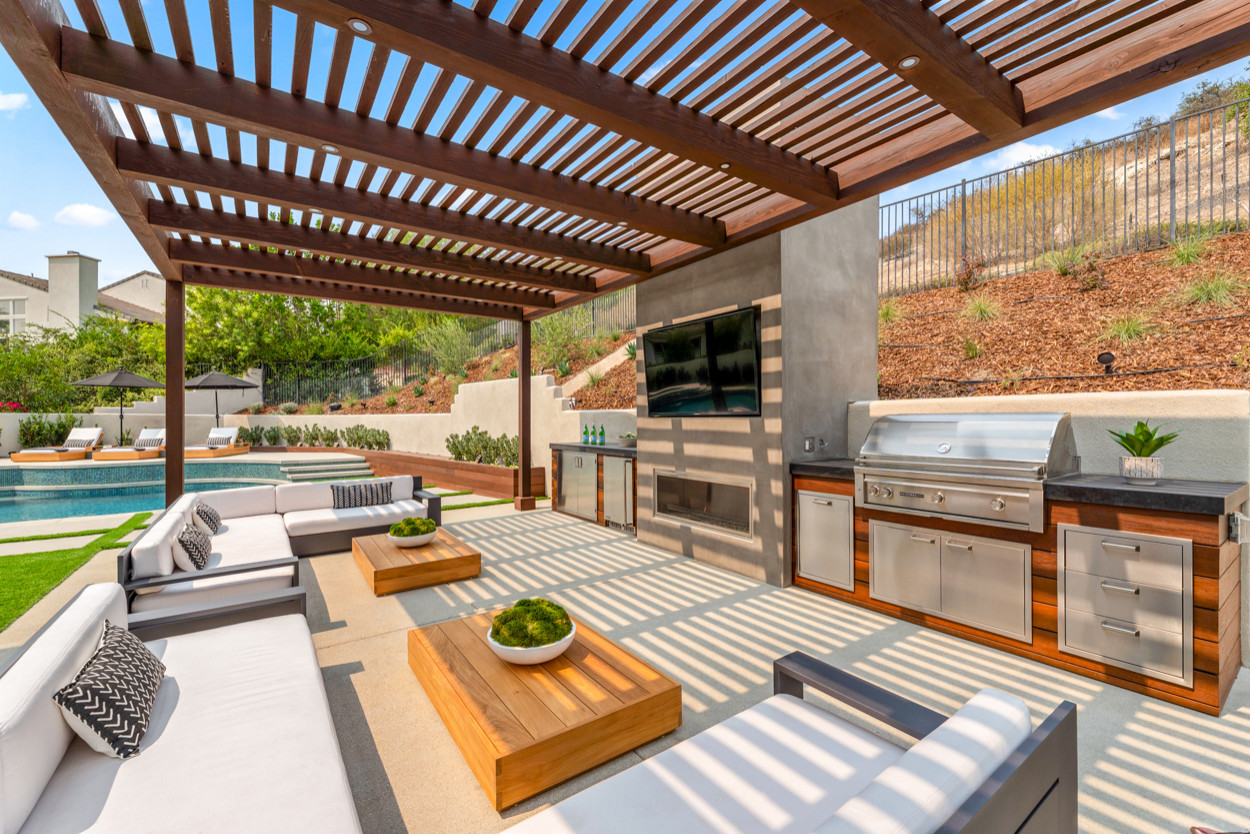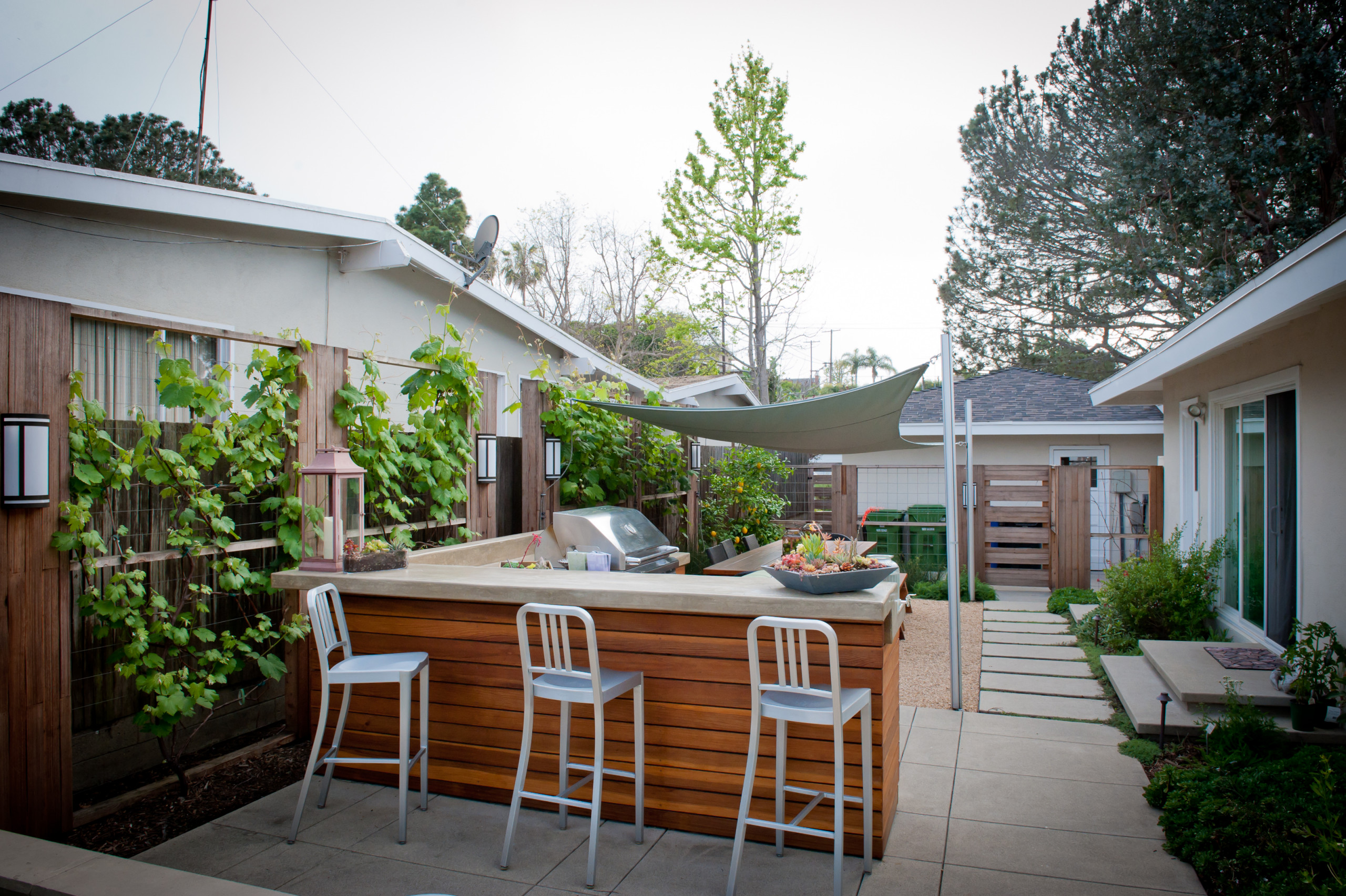

Douglass adds that ceramic grills, such as kamados, are versatile options that can work for any number of cooking styles. “They can be grills, smokers, roasters or even pizza ovens,” he says. Ongwiseth also recommends tailoring the grill selection to the food the homeowner likes to cook. “My family is more likely to stir-fry than grill our food,” he says.
 Argentine-style, or gaucho, grills also are becoming more popular, according to pros. The signature crank allows you to adjust the grill’s grate height for better control of cooking time and temperature.
Argentine-style, or gaucho, grills also are becoming more popular, according to pros. The signature crank allows you to adjust the grill’s grate height for better control of cooking time and temperature.
Landscape designer Janiece Snyder installed this style of grill instead of a traditional grill at a Los Angeles home. In one Chicago-area kitchen, Algozzini paired a standard grill in the outdoor kitchen with an Argentine grill set into the nearby fireplace.
 2. Convenient Location
2. Convenient Location
Pros recommend placing an outdoor kitchen in a convenient spot where it’s more likely to be used. Landscape designer Jennifer Hayman in Ontario, Canada, says she typically sites them just outside the house. “Homeowners don’t have to go so far when the Toronto weather is chilly or cold,” she says.
Danielle Killian, an associate of Ongwiseth’s, says that most cooks want to be at the center of the party, wherever it is happening. “Once one Los Angeles homeowner [we worked with] had a side-by-side grill and barbecue in the middle of her patio area and the ability to chat with guests, she rarely cooked inside, saving herself the cost of an interior kitchen remodel,” Killian says. Other homeowners, she adds, might prefer a little separation.
 Landscape architect Leslie Batten of Board & Vellum in Seattle likes to be aware of windows and doors when she’s locating outdoor cooking appliances. Wind direction is another important consideration, she says: “You want to avoid smoke blowing on your guests or back into your house.”
Landscape architect Leslie Batten of Board & Vellum in Seattle likes to be aware of windows and doors when she’s locating outdoor cooking appliances. Wind direction is another important consideration, she says: “You want to avoid smoke blowing on your guests or back into your house.”
Batten adds that some newer grills with infrared heating may have reduced flare-ups, which cuts down on smoke. “Or consider a hood if one is feasible for your kitchen setup without being an eyesore,” she says.
 3. Room to Move, Prep Food and Gather
3. Room to Move, Prep Food and Gather
A functional layout is always a priority in an outdoor kitchen design, regardless of size. “For us, whether an outdoor kitchen is straight, L-shaped or U-shaped is based on the number of components, the available space and how the client envisions their usage,” Algozzini says.
Douglass likes to create an L-shaped design whenever possible. “It gives you much more counter space for prep,” he says.


Algozzini recommends making the transition spaces as large as possible. “A cramped space minimizes utility and impacts the atmosphere and vibe,” he says.

Outdoor kitchens, even covered ones, are exposed to the elements and require hard-wearing materials and finishes. For that reason, Ongwiseth advises going with time-tested low-maintenance picks. “If homeowners are afraid of spoiling their beautiful kitchen, then it is less likely to be used,” he says.
He suggests choosing countertops that also resist grease and stains, such as polished and sealed smooth concrete. “Regardless of the care taken, things spill sometimes when the fun kicks in,” he says.

Douglass also recommends granite. “It’s durable, looks great and cleans easily,” he says. For outdoor installations, he suggests a 3-centimeter-thick granite counter instead of a thinner one. “The extra thickness will help with laminated seams,” he says. He also advises against using a full, laminated bullnose, saying that “extreme weather will cause problems in the long run.”


Przygoda-Montgomery says she often chooses high-end stainless steel options from Brown Jordan Outdoor Kitchens. “I am in love with this line,” she says. “It’s perfect for those who like to keep tools outside, and the color scheme is so fun.”
Ongwiseth offers this additional advice for extending the life of outdoor grills and appliances: “If the area is not under a roof extension or other structure, invest in good equipment covers to prolong the [kitchen’s] lifespan.”

Have fun with your kitchen’s style. Tim Zarra of Alderwood Landscape Architecture and Construction in Bellevue, Washington, likes to take design cues from the home. “We always make it a point for the design to fit the style of the house,” he says.
Przygoda-Montgomery opts for maximalist design and likes to bring in colors and patterns not often used in indoor kitchens. “Don’t play it safe,” she says. “Mix stripes with florals, and [be] boldly and unapologetically different.” If you can add a little unexpected color, as Przygoda-Montgomery suggests, so much the better.
 6. Party-Ready Appliances
6. Party-Ready Appliances
The pros recommend that after the essentials are in place, you personalize the kitchen with fun and functional appliances and accessories. Refrigerators top the list, but the choices are almost endless. “Smokers, trash receptacles, sinks and warming drawers are on our go-to list for an enhanced outdoor cooking experience,” Douglass says.

For those looking for a more elevated cooking experience, Przygoda-Montgomery also recommends built-in versions. They come in many sizes; some of the pizza ovens are large enough to require a crane for installation. “The effort isn’t fun, but it’s worth it,” she says.
 Douglass says that an ice maker can be a game changer for those who love outdoor living. “It’s worth spending a little more for a high-end brand that can handle tough weather conditions,” he says. He recommends choosing a model that produces pellet ice.
Douglass says that an ice maker can be a game changer for those who love outdoor living. “It’s worth spending a little more for a high-end brand that can handle tough weather conditions,” he says. He recommends choosing a model that produces pellet ice. 7. Storage and Lighting
7. Storage and LightingTry to include built-in storage, no matter how small the space. “People always think of it at the end of the project, but it should be considered at the beginning,” Mayer says.
The same advice holds for lighting. “You should plan for what you want when designing,” Mayer says. Batten likes to add dimmable lighting in strategic locations. “Just make sure any lights are not behind you when you’re at the barbecue or countertop, creating a shadow over your work area,” she says.
 8. Protection From the Elements
8. Protection From the ElementsAdding protection from the elements can make things more comfortable for cooks and guests. It also encourages you to use the kitchen during the shoulder seasons — or even through winter, depending on your region.
Batten says homeowners in the Pacific Northwest want to use their outdoor kitchens year-round. “Adding rain protection, whether with a custom or prefab canopy, greatly extends [the] options for accessing the barbecue or pizza oven despite the onslaught of rain,” she says. “Adding overhead infrared heaters means you can stay warm in the long winter nights.”
 Ceiling and wall fans help when the temperatures soar. Misters are another option for cooling things down. Przygoda-Montgomery recommends mister systems, especially given her Arizona locale. “In dryer climates, they are a must,” she says.
Ceiling and wall fans help when the temperatures soar. Misters are another option for cooling things down. Przygoda-Montgomery recommends mister systems, especially given her Arizona locale. “In dryer climates, they are a must,” she says. 9. Dining Area
9. Dining Area
Pros prefer having a dining spot nearby, especially if the kitchen lacks a counter or bar space. “Outdoor dining areas will normally be next to the outdoor kitchen, just as in a home’s interior,“ Algozzini says. “It sounds simple, but it’s a good guide to follow for practical use.”
Batten says that her firm adds a lot of custom-built dining benches outdoors. “Homeowners especially want ones with hidden storage,” she says.
 10. Edible Garden
10. Edible Garden
An edible garden — even a pot of herbs — adds greenery and offers fresh, convenient ingredients for outdoor cooking. “Some homeowners complement the outdoor kitchen with nearby edible gardens,” Killian says.
A well-designed outdoor kitchen can elevate your cooking and entertaining experience. From the grills, layouts, and materials to other elements pros use to create hardworking and stylish outdoor spaces. (cited)


The pros we spoke with agree: The grill is your starting point when designing an outdoor kitchen, so it’s important to pick what’s right for you. “Over time, the components may be different, but the impetus is the same: to design and build smart solutions that marry the appliances to the family’s cooking style or preferences,” says John Algozzini of Hursthouse Landscape Architects and Contractors in Bolingbrook, Illinois.
The right grill also can encourage you to head outside to prepare a meal, especially on warmer days. “Having a good outdoor stovetop minimizes the heat in the house and keeps associated food odors outside,” landscape designer Isara Ongwiseth of FormLA Landscaping in Los Angeles says.
Pros say they are seeing homeowners opt for top-quality appliances from the start. “They’re stepping up their outdoor game by installing commercial restaurant-quality appliances,” says designer Elizabeth Przygoda-Montgomery of Boxhill in Tucson, Arizona.